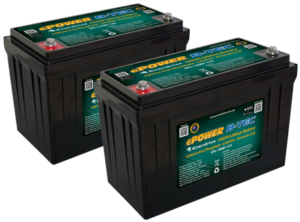I have a travel trailer. I was going to purchase 2 100aH batteries(each has a 100a BMS), but want to occasionally use a microwave with an inverter. The inverter would need to be 1500-2000 watts to power the Microwave(13 amps at 110V). This would mean drawing over 100 amps at 12 volts. Fine, I thought, I have 200 amps. But then I read somewhere about a “Ping Pong” effect. What that means is that one of the batteries BMS system would detect 100 amps and shut off. Then the second would take over, then detect over 100 amps, shut off, then the first would take over.
This would supposedly reduce the battery longevity, not to mention inverter or microwave stress.
Is this “ping pong effect” a real thing when using a large inverter? The solution would be one 200aH battery with a 200a BMS, but….
Edit - My initial alarm was a blog on an Australian site Enerdrive, which seems to be related to Dometic:
“The other question we always get asked is, what if I put 2 x 100Ah batteries together in parallel, can I use a 2000W inverter? Again we are talking about the Lithium batteries on the market that look like an “AGM” battery here.
As described above each battery has a maximum current output that can be achieved (100A per battery). The internal BMS setups have a safeguard built into their system. If a battery reaches/exceeds the maximum current output, the battery will switch off internally to protect the BMS and the cells from over discharge.
When this happens, the inverter and any loads running at the time are completely disconnected from the battery. Generally after 2-5 seconds, the battery BMS will switch the battery back on. If the large load is still present then the battery will just shut down again and the circle continues.

When you have 2 batteries in parallel and the above happens, the inverter/loads are transferred to the second battery, and in many cases will overload that battery and it too will switch off. By the time this happens, the first battery has switched back on and the loads return back to the first battery and again the circle continues.”
This would supposedly reduce the battery longevity, not to mention inverter or microwave stress.
Is this “ping pong effect” a real thing when using a large inverter? The solution would be one 200aH battery with a 200a BMS, but….
Edit - My initial alarm was a blog on an Australian site Enerdrive, which seems to be related to Dometic:
“The other question we always get asked is, what if I put 2 x 100Ah batteries together in parallel, can I use a 2000W inverter? Again we are talking about the Lithium batteries on the market that look like an “AGM” battery here.
As described above each battery has a maximum current output that can be achieved (100A per battery). The internal BMS setups have a safeguard built into their system. If a battery reaches/exceeds the maximum current output, the battery will switch off internally to protect the BMS and the cells from over discharge.
When this happens, the inverter and any loads running at the time are completely disconnected from the battery. Generally after 2-5 seconds, the battery BMS will switch the battery back on. If the large load is still present then the battery will just shut down again and the circle continues.
When you have 2 batteries in parallel and the above happens, the inverter/loads are transferred to the second battery, and in many cases will overload that battery and it too will switch off. By the time this happens, the first battery has switched back on and the loads return back to the first battery and again the circle continues.”
Last edited:


